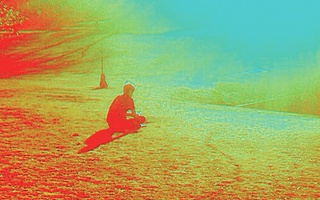We rarely experience a newsworthy event firsthand; rather, we encounter and consume it through breaking news reports, caps-locked headlines, montages of video clips, grim reporters, and emotional interviews. As we have seen, perhaps nothing provokes such instantaneous spectacle as surely as terrorism. It is this relationship between terror and spectacle that the exhibition “The Uncanny Familiar – Images of Terror” explores. The exhibition, whose opening corresponded with the 10-year anniversary of 9/11, is currently on view at C/O Berlin.
Such an exhibition must be careful of two obvious potential pitfalls. First, it risks becoming a mere extension of the very spectacle culture it purports to critique. Second, by representing terrorism in a contemporary art space, it risks aestheticizing and fetishizing these images of terror. “The Uncanny Familiar” is guilty of both, but not disastrously so. Ultimately the exhibition’s inconsistencies grant it great variety, which in turn allows for more nuanced and critical conversation.
The exhibition begins with the Munich Olympics and continues on through car bombing, hostage taking, and plane hijacking, before ending with 9/11 on the second floor. The central theme—how Terror proliferates within contemporary society—is better addressed by the program text than by most of the exhibition. Most of the works are dry, academic, and anemic. Images of chaos and debris are shown alongside polished advertisements and a montage of movie clips featuring the Twin Towers. The wall text spews out rhetorical questions: What is real and what is fiction? How do these images enter our collective unconsciousness? Is there a norm for how these subjects are depicted and how we then see them? The problem with these questions is not that they shouldn’t be asked, but that they are utterly generic; they could be asked of any exhibition of photography. For “The Uncanny Familiar” in particular, to be generic is not only to deny the charged tenor of the topic, but also to avoid acknowledging that the exhibition itself runs the risk of enabling this phenomenon of spectacular terror.
Though the medium of video would seem to be most obviously implicated in the perpetuation of this spectacle, it is also the only medium in which this exhibition adequately confronts the issue. Johan Grimonprez’s “Dial H-I-S-T-O-R-Y” (1997) intercuts animation, commercials, instructional video snippets, and movie clips with chronologically arranged news footage, suggesting connections between commercialism and sensationalism, the culture industry and mass media, film and spectacle, and spectacle and terror. The narrator speaks only two or three sentences at a time, encouraging even the most distracted viewer to consider his words. He conjectures that now we conceive of and live our lives as if for a film, that violence is the only act society takes seriously, that history is what we hear on the news.
Whereas “Dial H-I-S-T-O-R-Y” relies on lyricism, wittiness, and clever film editing to critique our society as enabling terror, Robert Boyd’s “Xanadu” (2006) does not so much criticize this conflation of terror and spectacle as exemplify and amplify it. Concentration camp corpses flop into mass graves, militias march, the Manson Family struts, bodies shudder at the force of bullets, religious fanatics rave, people plunge from the Twin Towers, and choreographed masses in the USSR, America, Nazi Germany, and Maoist China parade to disco beats across three screens in a full-room installation complete with disco ball. The manic montage sprints to an apocalyptic end, before Olivia Newton-John and Britney Spears start up again.
Boyd is critical, pointing out the absurdity inherent in our culture and spinning it to its grotesque extreme, but I wonder if such a position is productive. Can deliberate provocation do more than strengthen the culture of spectacle and up the ante for what we can already, staggeringly, tolerate? Can spectacle be used to overwhelm itself?
Fiorenza Menini’s “Untitled” (2001) represents the Twin Towers immediately after their fall, shrouded in dust and smoke. The camera hardly moves. The 28-minute video is devoid of sound, people, or digital manipulation. Our view of the spectacle is obscured by the event itself. It is harder to sit through than either “Xanadu” or “Dial H-I-S-T-O-R-Y;” by comparison, it is relentlessly boring. Music and shrill voices call from other videos in the exhibition. I got up before I forced myself to sit back down, alone in the empty room. “Untitled” writes us into the ghastly roles we fulfill daily, roles in the horrid inescapable system in which we are both victims and perpetrators. To leave “Untitled,” I decided, was to admit my dependence on spectacle. To stay was to confirm my role as a spectator.
“Conclusion: not every fact should be exploited from the spectator’s point of view. There are facts that cannot be viewed through binoculars,” wrote Osip Brik about film in 1925. The example he used was a man hitting another man.
—Columnist Kristie T. La can be reached at kla@college.harvard.edu.
Read more in Arts
Preview: The Shape of ThingsRecommended Articles
-
Pakistan: The Story Less ToldAt the start of this year, I was asked by a fellow freshman whether Pakistanbordered Indiana. When I replied in ...
-
‘Mortal Terror’ a Scattershot Take on Shakespeare’s LifeThe play fails to cohere dramatically or thematically, vacillating between terrorism and sordid affairs, comedy and drama.
-
War of TerrorThis past weekend, however, a great line has been crossed—and a great sacrifice made—in America’s seemingly never-ending “War on Terror.”
-
Sleigh Bell's Despondent FurySleigh Bells has added depth to the blaring potency that made them famous. While “Reign of Terror” is not as instantly stunning as “Treats,” the sophomore effort exhibits a new maturation.
-
Our Very Own Campaign of TerrorThe US needs to significantly reform its use of drones in the region, if not completely abolish it.
-
 "Terror" An Affecting Experiment in Fear
"Terror" An Affecting Experiment in Fear













